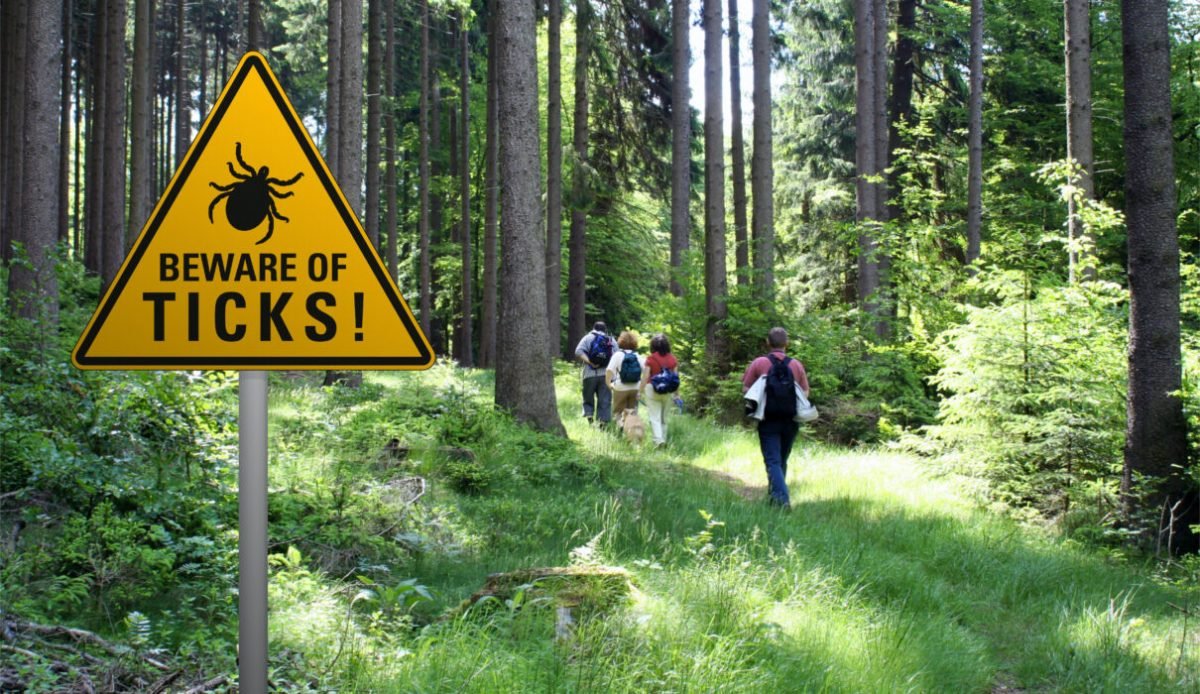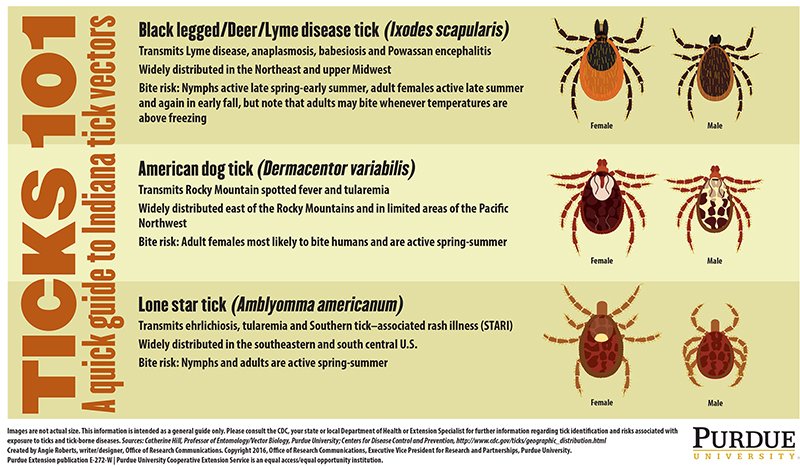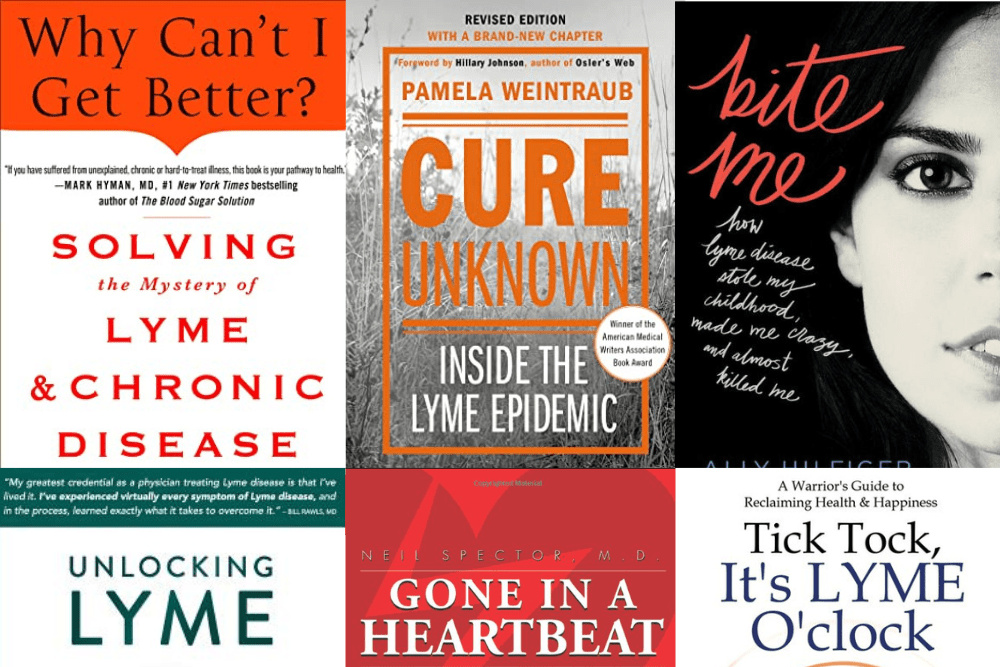LYME DISEASE RESOURCES
Heiko Barth/Shutterstock
Learn About Lyme Disease
Lyme disease is an inflammatory bacterial infection most commonly transmitted to humans by the bite of a blacklegged tick, which is a tiny tick, about the size of a poppy seed. Many people with Lyme disease never see a tick on them. Lyme disease can also be transmitted in utero from mother to child, via an infected blood transfusion or organ transplant, and possibly through sexual contact. Historically, there has been controversy surrounding Lyme disease due to poor diagnostics, insufficient treatment, a lack of research, and misinformation. When learning about Lyme disease, always consider the source! The source of the information on this page is me, Ellen Thompson, writer of Lyme Disease: The Musical. I battled Lyme disease for eight years. To read my story, click here.
The best sources for the latest information about Lyme disease are non-profit organizations and Lyme Literate medical professionals (LLMDs). An LLMD is an MD, DO, ND, PA-C, or NP who is specially trained by ILADS (International Lyme and Associated Diseases Society) and keeps up with the latest Lyme disease research and evidence-based treatment options. The worst sources for information about Lyme disease are the CDC (Centers for Disease Control and Prevention), the NIH (National Institutes for Health), your state health department, non-Lyme Literate medical professionals, medical text books, the media, and health insurance companies. I recommend the following organizations for accurate information about Lyme disease:
- LivLymeFoundation.org has information about Lyme and shareable memes
- GlobalLymeAlliance.org has information about Lyme and statistics for the math brains
- ProjectLyme.org has a nifty timeline of your Lyme journey
- BayAreaLymeFoundation.org has information about Lyme in people and pets, as well as the history of Lyme disease
- MothersAgainstLyme.org has information about congenital and childhood Lyme
How to Remove a Tick Properly
metel_m/Shutterstock
Step 1: Disinfect the bite area and tweezers or tick removal tool with alcohol.
Step 2: Grasp the tick firmly at its head with tweezers, as close to the skin as possible (TickEase tweezers are ideal). Alternatively, you can use a tick removal tool such as the Tick Patrol Tick Remover Tool.
Step 3: Pull straight up firmly and steadily until the tick lets go (or follow instructions for using tick removal tool).
Step 4: Identify the type of tick using this guide from the University of Rhode Island.
Step 5: If you want to get the tick tested for diseases, save it in a zip top bag or other small, sealed container, and see below for a list of labs that test ticks. If you don’t want to send it to a lab, you can murder a tick by submerging it in alcohol in a zip top bag and wrapping the whole thing tightly with tape. You can then toss it in the trash and dedicate your sacrifice to the diety of your choice.
Step 6: Wash your hands and the site of the tick bite.
Step 7: Swab the site of the tick bite with alcohol. Keep an eye on the area for signs of a rash.
Step 8: When there is a known blacklegged tick bite, ILADS recommends prophylactic treatment with 20 days of doxycycline. When there is a known blacklegged tick bite with a rash, ILADS recommends 4-6 weeks of doxycycline, amoxicillin, or cefuroxime, so see a Lyme Literate medical professional as soon as possible and tell them about the bite. Prompt treatment may prevent tick-borne diseases, including Lyme, from becoming chronic. To find a doctor, see the section below, How to Find a Doctor Who Treats Lyme.
Note: Never use petroleum jelly, nail polish, or a hot match when removing a tick. It won’t work!
How to Test a Tick
Angela Roberts/Purdue University
Testing a tick for diseases is easier, cheaper, and more accurate than testing a human or pet! And bonus, the tick dies in the process! Find out if you, your child, or your pet was exposed to tick-borne diseases by sending a tick in for testing. If disease is found in the tick and you’re not feeling well, take the test results to your Lyme Literate doctor or veterinarian. Below is a list of labs that test ticks. Prices are as of January 2023.
Tick Research Lab of Pennsylvania offers a free basic tick test panel, advanced panels are $50 and $100
Tick Check offers a free basic tick test panel, advanced panels are $100 and $200
Upstate Tick Testing Laboratory offers free tick testing for New York residents only
The Connecticut Agricultural Experiment Station offers free tick testing for Connecticut residents only
Texas Health and Human Services offers free tick testing for Texas residents only
The University of Maine Cooperative Extension offers tick testing for $15 for Maine residents only
University of Connecticut offers tick testing for $55, advanced panels are $85-$125
Ticknology Tick Testing Service offers 3 day tick testing for $35 and 24-72 hour testing for $55
Tick Report offers a standard tick testing package for $50, advanced panels are $100 and $200
ECO Laboratory offers tick testing for Lyme disease for $42, Lone Star or American Dog tick panel for $50, and blacklegged deer tick panel for $85
Test Ticks offers tick testing for Lyme disease for $55, advanced panel is $105
IGeneX Tick Testing offers tick testing for $75 per disease
Clongen Laboratories offers tick testing for $75 for one disease or $65 each for two or more diseases, except viruses, which are $200 each or $500 for all three (ColtiVirus, Heartland Virus, and Powassan Virus)
Learn About Lyme Symptoms
Click here for a comprehensive pdf checklist of Lyme disease symptoms. Keep in mind that Lyme can affect the entire body, including the brain, so it may present with mental health problems. In children, behavioral issues or learning difficulties may be the only symptoms. Click here for a list of cognitive and neurological Lyme disease symptoms in children.
Learn About Co-Infections
The term “Lyme disease” is sometimes used as an umbrella term for all tick-borne infections. Ticks that carry Lyme usually also carry other bacteria and viruses, which are called co-infections. Most people with Lyme disease suffer from co-infections. LymeDisease.org has information about co-infections and an excellent chart of tick-borne disease symptoms.
Take a Quiz to Find Out If You Might Have Lyme or Another Tick-Borne Infection
Find a Doctor Who Treats Lyme
insta_photos/Shutterstock
We say “Lyme Literate Doctor” or “Lyme Literate MD”, but keep in mind that many excellent Lyme specialists are DOs, NDs, Physician’s Assistants, or Nurse Practitioners. Here’s how to find a Lyme Literate practitioner (AKA “LLMD”) near you:
- Google “Lyme Literate Doctor” or “LLMD” and your geographical location
- Look for a doctor who is a member of ILADS. If the doctor is a member of IDSA (Infectious Diseases Society of America) RUN!! They don’t believe in chronic Lyme; science.
- Use ILADS’ Provider Search (requires login)
- Use LymeDisease.org’s Physician Directory (requires login)
- Use Lyme Disease Association’s Doctor Search (requires login)
- Message LivLymeFoundation using their online form
Get Tested for Lyme and Other Tick-Borne Diseases
Your Lyme Literate medical professional can tell you what tests you should get. Below are the top labs in the country for Lyme disease testing. Prices below are as of January 2023. If you need financial assistance with medical costs, check out this list of Lyme disease patient grants.
IGeneX offers testing for Lyme disease and co-infections. Tests range from $85-$200. IGeneX does not accept insurance.
The Laboratory for the Diagnosis of Lyme Disease at the Renaissance School of Medicine at Stony Brook University offers testing for Lyme disease. Tests range from $144-$309, and may be covered by your insurance. Check with your insurance company for details.
Medical Diagnostic Laboratories (MDL) offers testing for Lyme disease and co-infections. MDL will bill your insurance, but whether it’s covered is up to your individual plan. Check with your insurance company for details.
Vibrant Wellness offers testing for Lyme and co-infections as well as tick-borne viruses. Tests are only available through a medical provider. Vibrant Wellness does not accept insurance.
Learn About Treatment (and "The Lyme Wars")
Lyme disease is traditionally treated with oral or IV antibiotics and sometimes with herbal antibiotics. When antibiotics kill Lyme bacteria, the bacteria release endotoxins that cause a temporary flare in symptoms. This type of flare is called a Jarisch Herxheimer Reaction, and it’s why Lyme patients sometimes say antibiotics make them feel worse. These reactions are a sign that there is an active Lyme infection and the antibiotics are working. Enduring Jarisch Herxheimer Reactions is part of the healing process, but your Lyme Literate medical professional should balance your treatment with your quality of life.
ILADS is the premier association of Lyme Literate medical professionals, and they publish evidence-based treatment guidelines on their website. These guidelines differ significantly from the harmful IDSA treatment guidelines that are used by the US government and health insurance companies. The difference between ILADS treatment guidelines and IDSA treatment guidelines is what is referred to as The Lyme Wars.
I’ll explain the Lyme Wars like this: Imagine a group of doctors doesn’t believe cancer can survive one round of chemotherapy and asserts that anyone who still has cancer after one round of chemo is crazy. The government and health insurance companies agree and adopt this group of doctors’ treatment guidelines. Health insurance companies deny coverage for more than one chemo treatment, leaving patients in financial ruin.
But there’s another faction of doctors, those who believe the scientific research that says cancer requires more than one treatment. These doctors are maligned, dropped by health insurance companies, and sometimes lose their licenses to practice medicine. “It’s too dangerous to do more than one chemo treatment! There are bad side effects!” a chronic cancer denier doctor would say. “But we’re trying to save lives,” a science doctor would say. I think we can all agree that chemo is worth the side effects and risks because cancer is a life-threatening disease. I think we can also all agree that antibiotics are less dangerous than chemotherapy. In this analogy, the chronic cancer denier doctors are IDSA, and the science doctors are ILADS. Here’s a summary of ILADS treatment guidelines for Lyme disease:
- ILADS recommends against the use of a single 200 mg dose of doxycycline for the prevention of Lyme disease. Not only is it unlikely to be highly efficacious, in the human trial failed therapy led to a seronegative disease state.
- Based on animal studies, ILADS recommends that known blacklegged tick bites be treated with 20 days of doxycycline (barring any contraindications).
- Given the low success rates in trials treating EM rashes for 20 or fewer days, ILADS recommends that patients receive 4-6 weeks of doxycycline, amoxicillin or cefuroxime. A minimum of 21 days of azithromycin is also acceptable, especially in Europe. All patients should be reassessed at the end of their initial therapy and, when necessary, antibiotic therapy should be extended.
- ILADS recommends that patients with persistent symptoms and signs of Lyme disease be evaluated for other potential causes before instituting additional antibiotic therapy.
- ILADS recommends antibiotic retreatment when a chronic Lyme infection is judged to be a possible cause of the ongoing manifestations and the patient has an impaired quality of life.
Learn About Lyme Disease Prevention
I wrote, produced, and directed a handy hip-hop music video to help you learn how to prevent Lyme disease. Music was composed and produced by Lyme Disease: The Musical composer Hughie Stone Fish, and it stars Lyme Disease: The Musical‘s Brendan McCay and Taylor Murphy-Sinclair, as well as Tamara Mena, Siri Harkins, and Derek Ocampo. Share it with your friends and family!
Learn About Lyme Disease Research
megaflopp/Shutterstock
ILADS has a list with links to leading Lyme disease research articles in medical journals. Here are a few particularly interesting articles about Lyme disease studies:
“Horowitz: Dapsone + doxy + rifampin very effective for chronic Lyme” – LymeDisease.org 10/28/2020
Apply for Lyme Disease Patient Grants
Click here for our list of medical grants for adults and children suffering from Lyme disease.
Download Free Lyme Disease Apps
Lyme Symptom Tracker (iOS) is an app that helps patients keep track of Lyme disease symptoms and access clinical trials. Click here for the Android version.
Tick Tracker (iOS/Android) is the first app that helps users report and track ticks in real time. It was invented by LivLyme Foundation founder Olivia Goodreau when she was 13 years old!
Download and Share Lyme Disease Brochures
The LimeR Primer brochure from LymeDiseaseAssociation.org has extensive information about Lyme and co-infections. There’s also a version in Spanish.
The ABC’s of Lyme Disease brochure from from LymeDiseaseAssociation.org has a wealth of information for parents, caregivers, and educators about childhood Lyme disease.
The Psychiatric Lyme: What Every Mental Health Specialist Should Know About Lyme and Tick-Borne Illness brochure from ILADS.org is perfect to send to your psychiatrist, psychiatric nurse, or therapist.
The Tick-Borne Diseases Other Than Lyme brochure from ILADS.org covers co-infections Bartonella, Babesia, Anaplasma Phagocytophilum, Ehrlichia, Rocky Mountain Spotted Fever (RMSF), Powassan Virus, Tularemia, and Mycoplasmas.
Read Lyme Disease Books
Lyme: The First Epidemic of Climate Change by non-biased investigative reporter Mary Beth Pfeiffer is “superbly written and researched,” according to Booklist.
Why Can’t I Get Better? Solving the Mystery of Lyme and Chronic Disease by Dr. Richard I. Horowitz is the Bible for Lyme disease and co-infection information and treatment.
How Can I Get Better?: An Action Plan for Treating Resistant Lyme & Chronic Disease by Dr. Richard I. Horowitz is the follow-up to Why Can’t I Get Better, and features an action plan for healing.
Cure Unknown: Inside the Lyme Epidemic by science journalist Pamela Weintraub goes inside the controversy surrounding Lyme disease, making it the most comprehensive book ever written about the past, present and future of Lyme.
Unlocking Lyme: Myths, Truths, and Practical Solutions for Chronic Lyme Disease by Dr. William Rawls, is the sum of his experience and research and contains the practical solutions he used to get his own Lyme disease into remission using herbal remedies.
Gone in a Heartbeat: A Physician’s Search for True Healing by Dr. Neil Spector tells the story of Lyme disease bringing the doctor to the brink of death and in need of a heart transplant.
Bite Me: How Lyme Disease Stole My Childhood, Made Me Crazy, and Almost Killed Me by Ally Hilfiger tells the story of fashion designer Tommy Hilfiger’s daughter’s life-long battle with Lyme disease and its psychiatric symptoms.
Believe Me: My Battle with the Invisible Disability of Lyme Disease by Yolanda Hadid tells the story of the model and Real Housewife of Beverly Hills uncovering the mystery of Lyme disease.
Tick Tock, It’s LYME O’clock: A Warrior’s Guide to Reclaiming Health & Happiness by Christa Nannos is an easy-to-read guide for Lyme warriors and the people who love them.
Watch Lyme Disease Documentaries
I am so excited for you right now because you are about to watch some excellent documentaries about Lyme disease. You’ll laugh, you’ll cry… Okay, you won’t laugh, but you will cry because these films are powerful.
Under Our Skin (2008) is the first major documentary about Lyme disease, and it was nominated for an Academy Award! You can watch the entire film free on Youtube.
Under Our Skin 2: Emergence (2014) follows up on the first film. You can watch it free on Youtube as well.
The Quiet Epidemic (2022) follows a young girl from Brooklyn and a Duke University scientist who are diagnosed with chronic Lyme disease in their search for answers, which lands them in the middle of a vicious medical debate.The film is now available on AppleTV and Amazon. Check the film’s website for updates.
The Monster Inside Me (2022) is an inside look at Lyme Disease and its effects on regular people and their hard-fought relationships. It’s available for sale or rent on the film’s website.
I’m Not Crazy, I’m Sick (2023) chronicles the daily lives of three families and WNBA MVP Elena Delle Donne in their fight for survival against this insidious illness. The film is available on Apple TV and Google Play.
Educate Your Non-Lyme Literate MD or Become a Lyme Literate MD (for Medical Professionals)
Be very careful when talking to non-Lyme Literate doctors about Lyme disease. Most of them are too fragile to handle it, and many are eager to tell you it’s all in your head. Remember that if they didn’t miss class that day in med school, they learned that Lyme disease is only on the East Coast, it’s hard to get, easy to diagnose, and easily cured. Global Lyme Alliance has tips for talking to your non-Lyme doctors about Lyme disease.
If you’re lucky enough to find (or awesome enough to be) a medical professional who wants to learn about Lyme disease, send them to the ILADS page for providers. ILADS offers online courses for medical professionals and a physician training program to become Lyme Literate.
Help Find a Cure for Lyme Disease
MyLymeData is a patient-powered Lyme disease research project conceived and run by patients that lets Lyme disease patients learn from each other and provides data that can help drive Lyme disease research to improve their lives and help find a cure.
Find a Lyme Disease Support Group
Dr. William Rawls has a great list of Lyme disease support groups in the US, the UK, Australia, Ireland, and Canada. Also, be sure to search for groups on Facebook and Yahoo.
Become a Lyme Disease Advocate
Ground Picture/Shutterstock
Send a pre-written letter to congress with just one click! The website for the documentary The Quiet Epidemic provides an easy-to-use form.
The Center for Lyme Action hosts an annual Lyme Fly In Event in February where participants from across the US meet with the DC staff of their elected Representatives and Senators to advocate for increases in federal funding for Lyme disease.
Donate to Lyme Disease Research
Got money to burn and/or taxes to deduct from? Donate directly to Lyme disease research.
-
- The Stanford Medicine Lyme Disease Working Group
- Columbia University Lyme and Tick-Borne Diseases Research Center
- Johns Hopkins University and Medicine Attn: Department of Medicine/Lyme Disease Research Center PO Box 49143 Baltimore, MD 21297-9143






